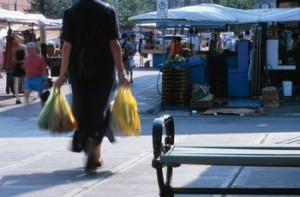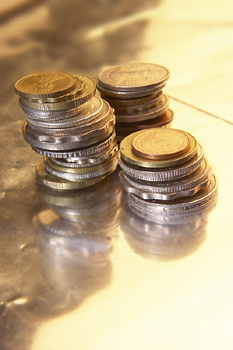Making Money at the Flea Market

Flea market retailing was once a way of life for thousands of small vendors across North America. It remains a way of life for hundreds of thousands of small vendors across the world, perhaps more than a million. If you can procure a source of goods that people want, you can sell them at the local flea market.
Farmers’ markets have now become more popular than flea markets. The main difference between a farmer’s market and a flea market is that you won’t find people selling off their old albums and furniture at the farmer’s market. In the old days when you could take your garden vegetables down to the flea market people would line up to buy your fresh corn, green beans, and peas. But obviously that idea caught on in a big way.
Professional flea market vendors fall into a few categories. They include retail store vendors who want to service people at the flea markets. These folks sell candies, gums, drinks, maybe little trinkets, and bags. Some retailers may also sell pre-packaged foods.
The next group are circuit traders. A circuit trader is someone who travels around a regular route buying up merchandise (like old paintings) to sell from his flea market stall. The circuit trader may be the guy with the biggest collection of “junk” in the flea market. He scours garage sales, estate sales, antique sales, storage facilities auctions, and maybe even the occasional junk pile for interesting stuff that owners don’t want any more but which may, if marketed properly, still prove to be interesting to someone else.
You also have the wholesale buyers who buy large volumes of goods like knives, camping gear, food stuffs, candles, and other hard-to-find items. These specialists probably face a lot of stiff competition from the Internet. Now you can buy just about anything directly from the source on the Internet.
Homecrafters and smallcrafters are people who make things like candles, doilies, blankets, purses, glassware, etc. in small shops or at home. They sell their small crafts at flea markets, farmer’s markets, street fairs and festivals, renaissance festivals, and just about any place that welcomes small vendors.
If you live in an area with a large hispanic population you may still find a mercado. Mercados are like indoor flea markets. Many mercado vendors earn their livings by selling homemade goods or imported goods, especially ethnic merchandise that may still be hard to find in the United States.
How to Run a Small Business at a Flea Market
So how do you make money in these small markets? First, you need to find something that you can sell which other people will have a hard time acquiring. That may be more along the lines of items you grow or manufacture yourself. But if you can work out a good discount through an online source, or if you have an eye for collectibles that are rare even on the Internet, you may be able to carve out a niche for yourself that works in your favor.
Think in terms of consumer things that are easily available in other parts of the country or world but which people don’t normally find in your area. That might be regional gourmet foods, regional art, and/or regional books and videos.
Once you figure out what you’re going to sell, set aside enough money to buy at least three months’ worth of inventory. Don’t buy it all at once. Buy just enough for one month (you also have to have a safe place to store your inventory). Once you have your products in stock figure out a floor plan for your vending stall.
You want people to find your products interesting and attractive. Price is part of the bargain, but you need to make a profit. A rule of thumb is about three times your cost of acquiring goods. If you pay $4 for a rare candle you’ll want to charge $12 for it. That may sound like you are making an $8 profit on the candle but your expenses will add up. You’ll be doing well if you make $2-4 on each candle.
You’ll also want some promotional materials. This should include flyers you can post around the market (if you are permitted to do so), information sheets and business cards to hand out to people who come by your stall, a sign or banner, and maybe little informative booklets about your products. The booklets make great items to sell.
If you are vending out-of-region products rather than local products you’ll want to come up with value propositions to use in marketing your goods, such as “we’re the only people in the south who sell huckleberries!”
Take the Right Equipment
You’ll need chairs to sit on, storage boxes for snacks and incidentals, a safe box for your money, possible a hand cart or hand cart to move your merchandise, rope or chains to tie things down, paper towels and spray cleaners for cleaning up messages, tables, and table cloths. Presenting a neat, clean storefront impresses your customers and makes you look professional.
Other things that may help include t-shirts for you and your assistants to wear, a folding/sandwich sign you can set up outside your stall (if permitted), a sign for your truck or car telling people where to find you, and maybe even a battery-powered audio system (if permitted) so you can play the right mood music for your customers. Some vendors even bring small TVs or computers and use them to show videos to their visitors.
You may want to have a drawing each day where you give away a prize. This is a great way to collect email addresses for a mailing list. So you’ll need a pad of signup forms or at least some paper.
If you are expected to track receipts you’ll need receipt pads, too. And pens.
You may need some lights. Battery-operated lights work best so you’re not dependent upon local power supplies (but use free electricity if it’s available as batteries are expensive). LED lights are more energy efficient and cost less to operate over time than regular incandescent bulbs.
Promote Your Flea Market Enterprise Outside the Flea Market
Tell people about your flea market business venture by leaving flyers on local bulletin boards at supermarkets, libraries, and public parks. You’ll have to put up new flyers every week or month so be sure you think of creative ways to change the message once in a while. You want people to remember you, not tune you out.
If you have a Website write a blog on it talking about the items you sell and sharing interesting stories about people who visit you at the flea market.
In short, be open and inviting in all ways possible. Your flea market business is as much about you as it is about making money because you need to enjoy what you do. If you don’t enjoy selling to people this is probably not the money making idea you should be pursuing.
Good luck on your new venture!

